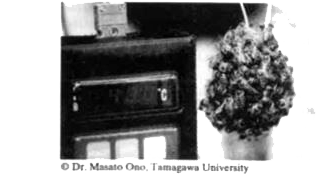The giant hornet Vespa mandarinia japonica preys on Japanes bees.However, if one of the hornets attempts to invade a beehive, several hundred of the bees quickly form a compact ball around the hornet to stop it. They do not sting, bits, crush , or suffocate it. Rather they overheat it by quickly raising their body temperatures from the normal 35∘C to 47∘ or 48∘C, which is lethal to the hornet but not to bees (Figure ). Assume the following : 500 bees from a ball of radius R = 1.8 cm for a time t = 18 min, the primary loss of energy by the ball is by thermal radiation, the ball's surface has emissivity ε=0.80, and the ball has a uniform temperature . On average, how much additional energy must each bee produce during the 18 min to maintain 47∘C ?

The correct Answer is:0.59J
Step by step video & image solution for The giant hornet Vespa mandarinia japonica preys on Japanes bees.However, if one of the hornets attempts to invade a beehive, several hundred of the bees quickly form a compact ball around the hornet to stop it. They do not sting, bits, crush , or suffocate it. Rather they overheat it by quickly raising their body temperatures from the normal 35^(@)C to 47^(@) or 48^(@)C, which is lethal to the hornet but not to bees (Figure ). Assume the following : 500 bees from a ball of radius R = 1.8 cm for a time t = 18 min, the primary loss of energy by the ball is by thermal radiation, the ball's surface has emissivity epsilon = 0.80, and the ball has a uniform temperature . On average, how much additional energy must each bee produce during the 18 min to maintain 47^(@)C ? by Physics experts to help you in doubts & scoring excellent marks in Class 12 exams.
Updated on:21/07/2023Topper's Solved these Questions
- HEAT-MEASUREMENT AND TRANSFERBOOK - RESNICK AND HALLIDAYCHAPTER - HEAT-MEASUREMENT AND TRANSFEREXERCISE - PRACTICE QUESTIONS
60 Videos
- HEAT-MEASUREMENT AND TRANSFERBOOK - RESNICK AND HALLIDAYCHAPTER - HEAT-MEASUREMENT AND TRANSFEREXERCISE - PRACTICE QUESTIONS(MORE THAN ONE CORRECT CHOICE TYPE )
8 Videos
- HEAT-MEASUREMENT AND TRANSFERBOOK - RESNICK AND HALLIDAYCHAPTER - HEAT-MEASUREMENT AND TRANSFEREXERCISE - CHECKPOINT 2
1 Videos
- GRAVITATIONBOOK - RESNICK AND HALLIDAYCHAPTER - GRAVITATIONEXERCISE - PRACTICE QUESTIONS (INTEGER TYPE)
4 Videos
- HYDROGEN ATOMBOOK - RESNICK AND HALLIDAYCHAPTER - HYDROGEN ATOMEXERCISE - PRACTICE QUESTIONS(Integer Type)
6 Videos
Similar Questions
Knowledge Check
In the following question, out of the given four alternatives, select
the alternative which best expresses the meaning of the
Idiom/Phrase.
Hornet's nestAa comfortable positionBan unpleasant situationCamong thornsDa dilemmaStir up a hornet's nest
ADestroy a nestBCall for dialogueCProvoke troubleDLead a revoltQuickly : Safely
ASaturation : SemaphoreBShallow : ThreateningCVindictive : WhoopeeDUsually: Without
She has a bee in her bonnet and can say anything.
View SolutionWhich one is the real product of honey bee ?
View SolutionTogether in what is known as a bee _________ the head of the bees is called the
View SolutionAnimals that rely on the heat from the environment , rather than of metabolism, to raise their body temperature are, in the strict sense, called
View SolutionBee sting contains:
View Solution
